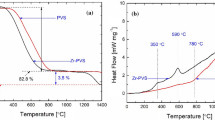Abstract
We have undertaken a systematic study of the oxidation chemistry for a range of SiOC ceramics derived from silsesquioxane polymeric precursors. This study examines the oxidation for 500 hours at 600, 800, 1000 and 1200°C for four SiOC powders. The material changes upon oxidation were characterized qualitatively by color change and optical microscopy and quantitatively by weight and composition change. In this study we employ a very easy method that uses the weight change upon oxidation and a carbon analysis after oxidation to arrive at the composition of the oxidized SiOC. Combined these qualitative and quantitative techniques have shown that on oxidation at 800 and 600°C the SiOC composition is more rapidly changed to that of silica than oxidation over the same time frame at 1000 or 1200°C. The data indicates that this difference is due to the relative rates of oxidation of the excess carbon versus the Si—C bonds in the SiOC. At lower temperatures initially the carbon oxidation predominates which leads to higher porosity throughout the material and an increase in the surface area with eventually ‘complete’ oxidation to silica. At higher temperatures the Si—C bond oxidation rate is comparable to the rate of oxidation of carbon. This allows a silica-like surface to build up on the SiOC, which slows all subsequent reactions due to the necessity to diffuse O2 in and COx out of the bulk. Under these oxidation conditions materials that originally contain high amounts of excess carbon are more quickly oxidized to silica than those that contain minimal amounts of excess carbon, as confirmed by elemental analysis and optical microscopy. Regardless of the time or temperature of the oxidation conditions no materials were found to be completely stable to oxidation. SiOC materials with low levels of excess carbon showed the best resistance to change upon oxidation.
Similar content being viewed by others
References
F. Chi, Ceram. Eng. Sci. Proc. 4, 704–717 (1983).
D.A. White, S.M. Oleff, R.D. Boyer, P.A. Budinger, and J.R. Fox, Adv. Ceram. Mater. 2, 45–59 (1987).
H. Zang and C.G. Pantano, J. Am. Ceram. Soc. 73, 958–963 (1990).
F.I. Hurwitz, J.Z. Gyekenyesi, P.J. Conroy, and A.L. Rivera, Ceram. Eng. Soc. Proc. 11, 931–946 (1990).
P.N. Adler, Int. SAMPE Symp. Exhibit 41, 524–531 (1996).
L.M. Manocha and S.M. Manocha, Carbon 33, 435–440 (1995); (b) M. Harris, T. Chaudhary, L. Drzal, and R.M. Laine, Mater. Sci. and Eng. 195A, 223–226 (1995).
W. Xing, A.M. Wilson, K. Eguchi, G.A. Zank, and J.R. Dahn, J. Electrochem. Soc. 144, 2410–2416 (1997).
See http://www.ccr.jussieu.fr/lcmc/Tmr/SiOC.html.
D.R. Bujalski, S. Grigoras, W.-L. Lee, G.M. Wieber, and G.A. Zank, J. Mater. Chem. 8(6), 1427–1433 (1998).
G.M. Renlund, S. Prochazka, and S. Doremus, J. Mater. Res. 6, 2716–2722 (1991); (b) G.M. Renlund, S. Prochazka, and S. Doremus, J. Mater. Res. 6, 2723–2730 (1991).
H. Zhang and C.G. Pantano, Mater. Res. Soc. Proc. 271, 783–788 (1992).
G.T. Burns, R.B. Taylor, Y. Xu, A. Zangvil, and G.A. Zank, Chem. Mater. 4, 1313–1320 (1992).
G.D. Soraru, J. Sol-Gel Sci. Technol. 2, 843–848 (1994).
R.J.P. Corriu, D. LeClercq, P.H. Mutin, and A. Vioux, J. Sol-Gel Sci. Technol. 4, 327–337 (1997).
M.A.B. Meador, F.I. Hurwitz, and S.T. Gonczy, Ceram. Eng. Soc. Proc. 17, 394–400 (1996).
G.T. Burns, T.P. Angelotti, L.F. Hanneman, G. Chandra, and J.H. Moore, J. Mater. Sci. 22, 2609–2676 (1987).
F.I. Hurwitz, P. Heimann, S.C. Farmer, and D.M. Hembree, J. Mater. Sci. 28, 6622–6630 (1993).
R.H. Baney, K. Eguchi, and G.A. Zank, Soc. Chem. Japan 8, 23–28 (1996).
L.M. Manocha, D.Y. Vashistha, and S.M. Manocha, Mater. Sci. Forum 223–224, 127–132 (1996).
B. Dacic and S. Marinkovic, Carbon 25, 409–415 (1987); (b) P.L. Walker, Carbon 28, 261–279 (1990); (c) T.-M. Wu, W.-C. Wei, and S.-E. Hsu, Carbon 29, 1257–1265 (1991); (d) S.M. Gee and J.A. Little, J. Mater. Sci. 26, 1093–1100 (1991); (e) B. Dacic and S. Marinkovic, Carbon 25, 409–415 (1987).
Author information
Authors and Affiliations
Rights and permissions
About this article
Cite this article
Brewer, C.M., Bujalski, D.R., Parent, V.E. et al. Insights into the Oxidation Chemistry of SiOC Ceramics Derived from Silsesquioxanes. Journal of Sol-Gel Science and Technology 14, 49–68 (1999). https://doi.org/10.1023/A:1008723813991
Issue Date:
DOI: https://doi.org/10.1023/A:1008723813991




